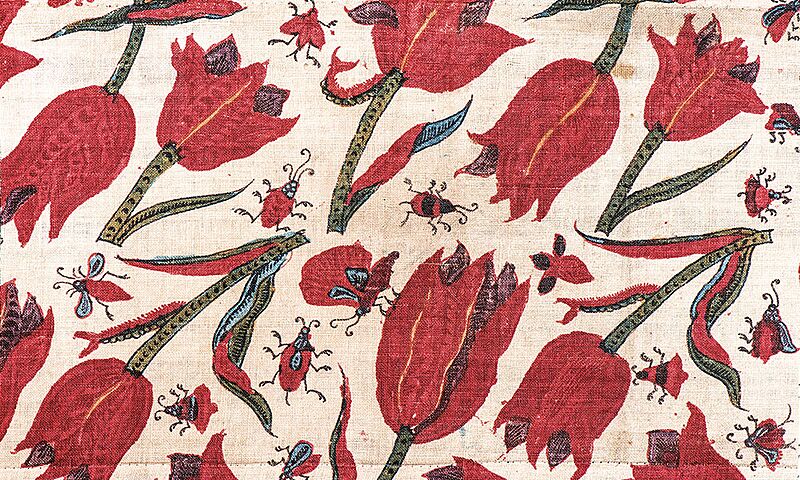Image: Chintz fragment with tulips and insects

Description: Chintz fragment with tulips and insects (reportedly found in Japan), Coromandel Coast, India, ca.1700-30. 0.13 x 0.20 m (5″ x 8″). Hand-drawn on cotton cloth using dyes, mordants and resists. Karun Thakar Collection Ben Evans muses on how this fact and its historical significance can be understood through the lens of Indian textiles: For me, this chintz fragment has always loomed larger than its diminutive size since it unites a number of strands of interest in one object. It is a small piece of seemingly unimportant cloth in which, by looking a little deeper, one can see that the lively drawing of tulips and insects is sketched in a manner reminiscent of botanical drawings of the 17th century, when European artists were recording the natural world. These have been copied by Indian artists with a vibrancy that, according to one expert, reflects the tulips seen on VOC export porcelain from the mid-17th century. That in itself is a remarkable instance of trade and design transfer, but the fact that this fragment was found in Japan adds another layer to its story. The HALI Tour to Japan in 2019 revealed the extraordinary reverence paid there to Indian cotton, a fabric that in Britain, and perhaps elsewhere in the West, had lost its lustre and appeal through its ubiquity—indeed the adjective ‘chintzy’ even became a pejorative term. The care taken to preserve the textile and the value attached to its function instils this humble scrap of cloth with new meaning for me and can serve as a metaphor for the appreciation of Indian textiles exported for generations across the world.
Title: Chintz fragment with tulips and insects
Credit: https://hali.com/news/hali-the-india-edition/
Author: Karun Thakar Collection photo. Work by unknown Coromandel srtisans
Permission: This is a faithful photographic reproduction of a two-dimensional, public domain work of art. The work of art itself is in the public domain for the following reason: Public domainPublic domainfalsefalse This work is in the public domain in its country of origin and other countries and areas where the copyright term is the author's life plus 100 years or fewer. You must also include a United States public domain tag to indicate why this work is in the public domain in the United States. This file has been identified as being free of known restrictions under copyright law, including all related and neighboring rights. https://creativecommons.org/publicdomain/mark/1.0/PDMCreative Commons Public Domain Mark 1.0falsefalse The official position taken by the Wikimedia Foundation is that "faithful reproductions of two-dimensional public domain works of art are public domain". This photographic reproduction is therefore also considered to be in the public domain in the United States. In other jurisdictions, re-use of this content may be restricted; see Reuse of PD-Art photographs for details.
Usage Terms: Public domain
License: Public domain
Attribution Required?: No
Image usage
The following page links to this image:

